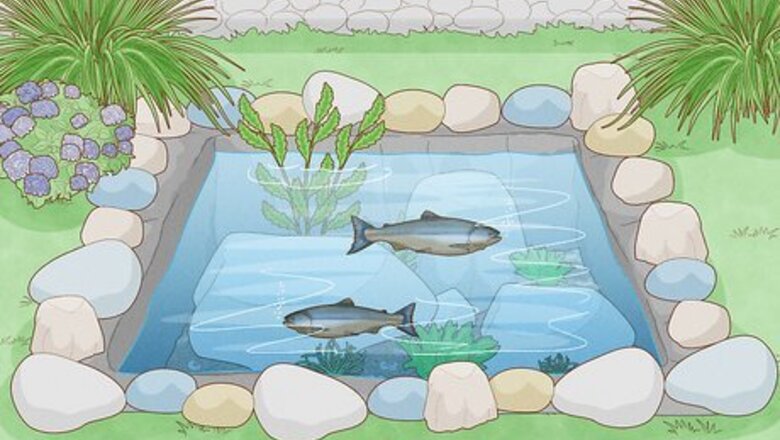
views
Can you raise your own salmon?

Yes! You can absolutely raise your own salmon. You can raise salmon right in your own backyard. In fact, backyard fish farming is a lot like vegetable gardening. All you need to do is create a healthy environment, add your salmon, and feed them. Once the fish are fully grown, you can harvest them whenever you like. Also, just like gardening vegetables requires care and maintenance, you’ll need to regularly check on and maintain your backyard salmon farm.
Can salmon be farmed in freshwater?

Yes, you can raise salmon in freshwater with a closed containment system. Salmon in the wild mostly live in saltwater and swim to freshwater once a year to spawn and create the next generation of fish. However, salmon can be farmed in freshwater tanks or systems that are designed to prevent escapes and problems with sea lice, which commonly infest salmon that are farmed in open-water, netted systems. There have been many advancements in freshwater salmon farming, including the development of feed that reduces the amount of wild feed fish needed to sustain the salmon. Selective breeding has also helped to create salmon that thrive in freshwater environments.
How do you build a fish pond in your backyard?
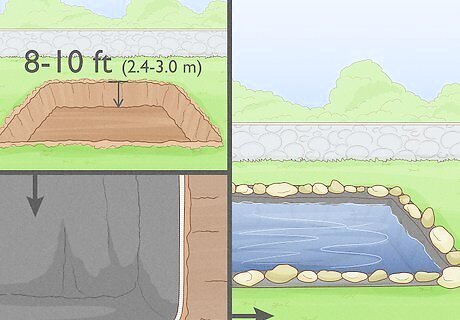
Dig out the pond in a low area that naturally collects water. Take a look around your backyard to choose a spot where rainwater collects after a storm to figure out where the low spots are. Sketch out the size and shape of the pond to use as a guide. Use a shovel, hire a contractor, or rent heavy machinery such as a bobcat or back-hoe to dig out the pond and be sure to include an area of the pond that’s between 8–10 feet (2.4–3.0 m) deep so the salmon have a cooler area if they need it. No matter how large your pond is, a basic rule of thumb is it needs to be at least 8 feet (2.4 m) deep in 5-10% of the pond area to make sure your fish have enough room and oxygen. If you aren’t very experienced with earthworks, hire a contractor who will have all of the necessary tools and machinery. Before you dig, contact your local utility company to make sure there aren’t any buried power lines in your yard. If you’re in the US, you can call 811 to find out.
Add mason’s sand, geo textile fabric, and a pond liner. Mason’s sand is ultra-fine concrete sand that will create a soft bottom layer for your pond liner. Lay an even layer over the entire bottom surface of the pond. Then, lay a geo textile fabric flat on top of the sand. Finally, lay a pond liner, which is rubber sheet that will help your pond hold in the water, on top of the geo textile fabric. The pond liner, geo textile fabric, and sand will help prevent water loss and create a smooth surface at the bottom for your fish. The geo textile fabric will also help protect the rubber liner. Press and smooth out the pond liner as best as you can. The water will help hold it in place.
Fill the pond with water flowing down a plastic sheet. If you start filling the pond with a hose in 1 location, it can cause erosion and carve out a hole in the soil and sand beneath the liner. Instead, place plastic sheet in the pond and place your hose on top of it so the water flows more gently into the pond. Once the pond is full, you can remove the sheet and hose.
Do I need to test the quality of my pond water?
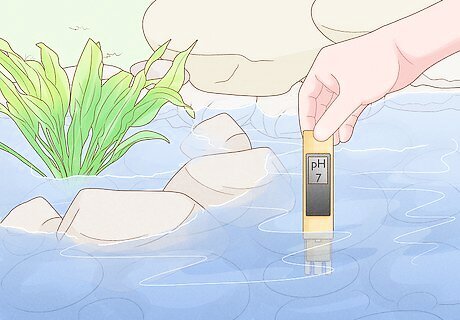
Yes, it’s important that the pH level is balanced. Testing water quality is also super easy to do. Pickup a simple home testing kit, take a sample of the water, and use the color code to interpret the results. The ideal pH level is close to 7. If you need to raise or lower the pH of your water, there are a variety of commercial products you can add to your water to balance it. Your salmon may not survive if the water in the pond has too high or too low of a pH. If you want to use natural products, crushed coral can raise the pH and bogwood or limestone can lower it.
Do you need to oxygenate a backyard fish pond?

Yes, you need at least 1 method of oxygenating the water. Stream dwelling fish like salmon and trout need a high level of dissolved oxygen in the water. Install a fountain, artificial waterfall, water flow form, or another water feature that oxygenates the water before it drops into the pond. You could also direct a steady flow of water from a nearby source into your pond with a pipe or weir, which will help oxygenate your pond water.
How do you add salmon to a fish pond?

Introduce the salmon into the pond with the water they came in. You can buy young and adult salmon from a local hatchery, or you can order them online. When you purchase or order salmon, they’ll arrive in plastic bags or containers full of water. Place the containers into your pond to bring the water to the same temperature and then release the fish into your pond along with the water in the container so the fish can more easily adjust to the surrounding water. Leave the container in the water for about 15-30 minutes to regulate the temperature. While you can place salmon eggs in your pond and hope they hatch, it’s much easier to start with young or adult salmon.
How do you feed salmon in a pond?

Regularly give them salmon feed and avoid overfeeding them. High-end salmon feed will provide your fish with high-quality nutrition while they grow in your pond. Check the packaging to determine how much you need to feed your fish based on the number of salmon that you have in your pond. Be careful not to overfeed your salmon, which can cause problems with bacteria and fungus.
How long does it take to farm salmon?

It takes 2 years for salmon to reach full size. The time it takes until you can harvest and eat the salmon in your pond depends on how old the fish were when you added them. If they were grown from eggs, you’ll want to wait until they reach adulthood after about 2 years. But if you add adult fish to your pond, you can harvest them whenever you like! After about 2 years, salmon raised in a pond will be about 20 inches (51 cm) long.
How can I sustainably raise salmon in a pond?
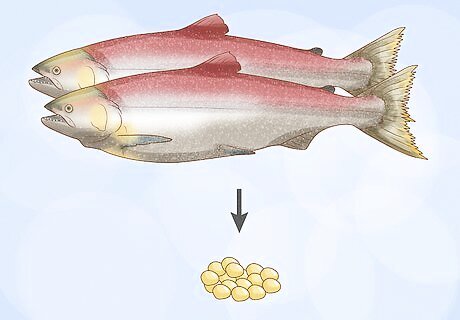
Allow the salmon to reproduce and avoid overharvesting them. As long as you don’t harvest all of the salmon in your pond, they’ll eventually breed, lay eggs, and create more salmon! Take care of your salmon, feed them regularly, and only harvest a fish when you plan to eat it and your pond can sustainably supply you with a fresh source of salmon!











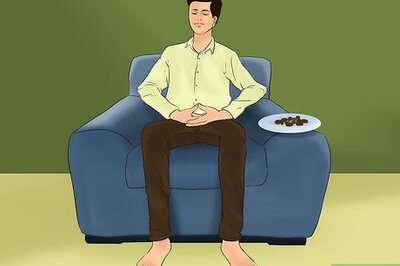






Comments
0 comment